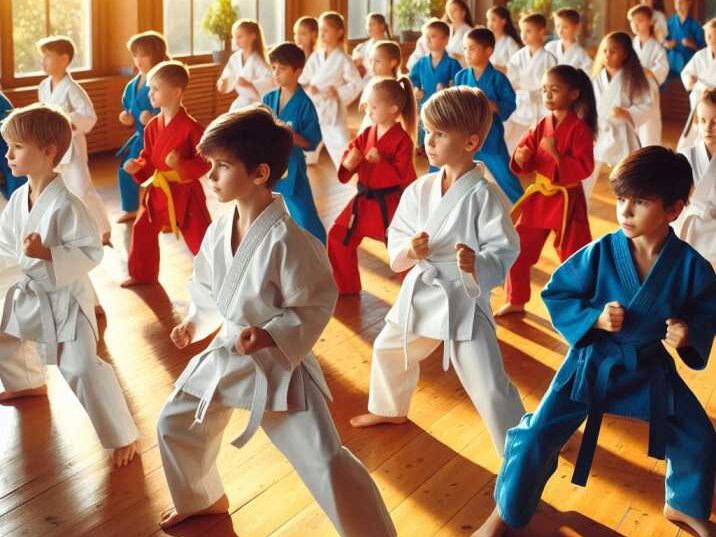Introduction
Table of Contents
Parents often ask how active martial arts really are and how many calories does martial arts burn. You may wonder if your child gets enough exercise from karate, taekwondo, or judo compared to soccer or swimming.
Calories burned matter because they connect to health, weight control, and energy balance. For kids, it’s about building habits, staying fit, and enjoying movement.
This guide breaks down how many calories martial arts can burn, why it matters for children, and how to keep training safe and fun. You’ll also see tips, risks to watch for, and a clear breakdown of benefits.

What Does “Calories Burned” Mean?
Calories are units of energy. Every activity, from running to sitting, uses energy. The faster or harder your child moves, the more calories they burn.
Martial arts burn calories because they involve kicks, punches, stances, sparring, and drills. Movements combine cardio, strength, and flexibility.
For children, the actual number depends on:
- Age and weight
- Type of martial art
- Training intensity
- Duration of class
On average, a child weighing 70 pounds burns 300–400 calories in a one-hour martial arts class. A heavier child or teen may burn 500–600 calories in the same time.
Calories Burned in Different Martial Arts
Not all martial arts are the same. Some styles focus on fast movement and cardio, while others are slower but use strength and balance.
Benefits of Martial Arts for Kids
1. Improves Fitness
Martial arts classes are designed to keep kids moving from start to finish. They include warm-ups, stretching, drills, sparring, and games that combine both cardio and strength. This variety helps children improve endurance by keeping their hearts active for long periods. At the same time, they develop agility through quick kicks and footwork. Coordination grows as kids learn to balance, punch, and move in rhythm. Over time, these fitness skills carry over into everyday life, from school activities to playground games.
2. Burns Calories and Manages Weight
Martial arts are a high-energy activity, which means kids burn hundreds of calories in a single class. This regular calorie burn helps prevent unhealthy weight gain and keeps children in a healthy range for their age. Active movement also supports metabolism, which is the body’s ability to turn food into energy. When paired with balanced eating, martial arts can be an effective tool for weight management. Parents will also notice their children having more energy throughout the day. Staying active in this way sets a foundation for lifelong healthy habits.
3. Builds Confidence
Martial arts give kids the chance to learn real self-defense skills, which makes them feel more secure in daily life. Discipline is built into every class through consistent practice and goal setting. As children progress and earn new belts or master techniques, they see the results of their hard work. These achievements directly boost self-esteem and encourage them to keep improving. Confidence gained on the mat often carries into school, friendships, and other activities. Over time, kids learn to believe in themselves and their abilities.
4. Teaches Focus and Respect
Every martial arts class runs on structure, which helps kids learn the value of routine and order. Instructors expect students to pay attention, follow directions, and stay engaged during lessons. This improves focus, which benefits schoolwork and other learning environments. Respect is also central, as children bow to teachers, listen carefully, and treat classmates kindly. They learn that progress comes from discipline and cooperation, not shortcuts. These values become habits that guide behavior outside the dojo too.
5. Reduces Screen Time
Many children spend hours sitting in front of TVs, phones, or tablets, which can harm their health. Martial arts provide a positive and active alternative that gets kids moving. Training keeps them engaged physically and mentally, reducing the urge to sit for long periods. This shift helps prevent issues like poor posture and low energy. Parents often find that regular classes replace screen time with a fun and healthy habit. Over time, children become more active and balanced in how they spend their free time.
Possible Risks or Concerns
Injury Risk
Like any sport, martial arts carry the chance of small injuries such as sprains, bruises, or bumps. These usually happen during sparring or when kids try new moves too quickly. Most injuries are minor, but without supervision, they can become more serious. Parents should know that safe training spaces and proper gear reduce these risks. When instructors emphasize technique over force, children learn how to move safely. Injury risk is manageable with the right guidance.
Overtraining
Some kids love martial arts so much that they want to practice every day. While enthusiasm is great, too many classes without rest can lead to fatigue. Overtraining can cause muscle soreness, low energy, and even stress. Children need time to recover so their bodies can grow stronger. Parents should balance martial arts with school, play, and rest. A healthy routine prevents burnout and keeps training enjoyable.
Competition Pressure
Tournaments can motivate some children, but they can also bring stress. Not every child enjoys competing or performing in front of others. Pressure to win may lead to anxiety, frustration, or disappointment. Parents should keep competition optional and focus on learning and growth instead. Supportive instructors can teach kids to see competition as practice, not just about winning. This way, tournaments become a positive experience.
Mismatched Style
Not all martial arts are the same, and not every child connects with every style. Some arts, like judo, are very physical, while others, like aikido, are slower and focused on technique. If the style doesn’t match your child’s personality or energy level, they may lose interest. Parents should let kids try a few classes before committing. The right match makes training exciting and sustainable long term.
Safety Tips for Parents
Choose a Certified Instructor
A good instructor is the key to safe martial arts training. Certified teachers know how to teach kids at the right pace and correct mistakes early. They create a positive and structured environment that supports learning. Parents should look for schools with qualified staff and clear safety policies. Asking about certifications and experience is always a smart step.
Make Sure the Dojo or Gym Has Safety Mats and Gear
The training space matters as much as the instructor. Dojos should have padded mats to protect kids when they fall or practice takedowns. Good gyms also provide clean and well-maintained gear for safe practice. A safe environment lowers the risk of accidents. Before enrolling, parents should tour the facility and check the condition of equipment.
Encourage Your Child to Warm Up and Stretch
Warm-ups prepare muscles and joints for movement, lowering the chance of injury. Stretching helps kids stay flexible and ready for kicks, punches, and rolls. Skipping this step can lead to strains or stiffness. Parents should remind children about the importance of these routines. Over time, kids learn healthy habits that carry into all physical activities.
Buy Proper Protective Equipment
Protective gear is essential in martial arts, especially for sparring. Items like mouthguards, gloves, and shin guards reduce the impact of strikes. Well-fitted gear also gives kids confidence to train harder without fear of injury. Parents should invest in good-quality equipment rather than cheap alternatives. Safety gear is an investment in your child’s health and comfort.
Limit Classes to 2–4 Times Per Week
Martial arts should challenge kids but not overwhelm them. Attending too many classes per week may cause exhaustion and take time from other activities. Two to four classes give enough training for progress without burnout. Parents should balance martial arts with schoolwork, family time, and rest. This schedule keeps kids excited and motivated.
Remind Your Child to Drink Water Before, During, and After Class
Hydration is often overlooked, but it’s crucial during active sports. Kids lose water through sweat, and dehydration can make them tired or dizzy. Drinking before, during, and after class keeps energy levels stable. Parents should encourage children to carry a water bottle to every practice. Staying hydrated helps kids perform better and recover faster.

Comparison with Other Activities
Martial arts burn calories at a similar rate to many sports.
Soccer: 350–500 Calories Per Hour
Soccer is a high-energy sport that keeps kids running almost nonstop. The mix of sprinting, kicking, and teamwork makes it a strong calorie burner. Children also develop endurance and coordination while playing. Martial arts provide a similar level of activity, but with more focus on individual growth rather than team play.
Swimming: 400–600 Calories Per Hour
Swimming works the whole body, engaging both the upper and lower muscles. Because water adds resistance, kids burn calories quickly during laps or drills. It also builds lung capacity and strength. Martial arts match swimming in calorie burn but add skills like self-defense and discipline that water activities don’t cover.
Basketball: 400–600 Calories Per Hour
Basketball involves constant running, jumping, and quick changes in direction. These movements make it a strong cardio workout and a great calorie burner. Kids also learn teamwork and strategy through the game. Martial arts, while sometimes less team-focused, deliver similar calorie burn with added structure and respect training.
Martial Arts: 300–600 Calories Per Hour
Martial arts vary by style, so the calorie burn can range widely. Fast-paced classes like kickboxing are on the higher end, while slower styles like aikido may burn less. Still, martial arts provide a complete workout combining cardio, strength, and flexibility. Beyond calories, kids gain confidence, focus, and self-control.
This shows martial arts are equal to or better than most sports for calorie burning. Plus, they add self-defense and discipline, which team sports may not provide.
How Many Calories Does Martial Arts Burn Per Hour (for a 70–100 lb child)
| Martial Art | Calories Burned (per hour) |
|---|---|
| Karate | 300–500 |
| Taekwondo | 350–550 |
| Judo | 400–600 |
| Brazilian Jiu-Jitsu | 350–500 |
| Kung Fu | 400–600 |
| Kickboxing | 450–650 |
| Aikido | 300–450 |
Conclusion
Martial arts are more than self-defense. They are a powerful way for kids to stay fit, burn calories, and build confidence.
On average, children burn 300–600 calories per class, depending on the style, intensity, and their weight. This matches or beats many traditional sports.
As a parent, your role is to guide your child toward safe practice, balance training with rest, and celebrate the life skills martial arts bring. Encourage your child to enjoy the journey, not just the calorie count.
FAQs
1. How many calories does a kid burn in karate?
A 70-pound child burns about 300–400 calories per hour in karate.
2. Is martial arts good for weight loss in kids?
Yes. Regular practice helps kids maintain a healthy weight when combined with balanced eating.
3. Which martial art burns the most calories?
Kickboxing and judo are among the highest, burning 450–650 calories per hour.
4. Can martial arts replace gym workouts for kids?
Yes. Martial arts mix cardio, strength, and flexibility, making them a full-body workout.
5. Is martial arts safe for young children?
Yes, if taught by certified instructors with proper safety gear and age-appropriate drills.


